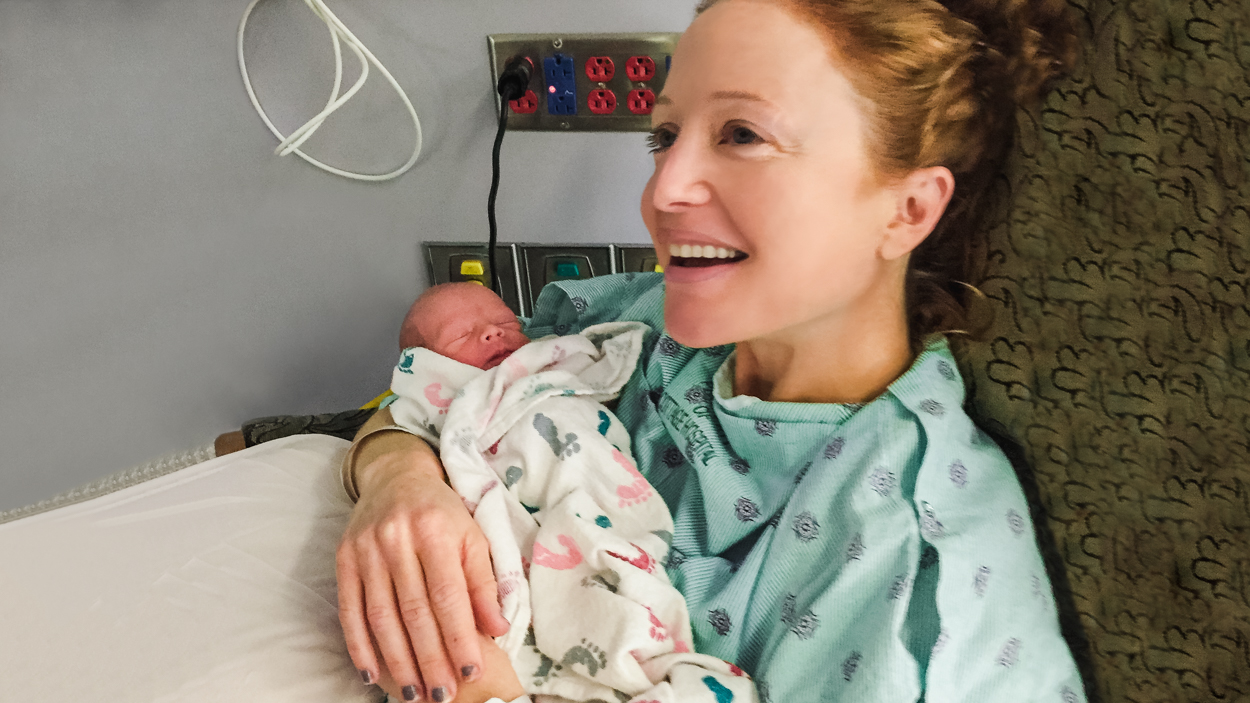

Approved by the What’s Up Moms Medical Advisory Board
Even if you have a low-risk pregnancy and expect your labor and delivery to be brilliantly, blandly textbook, it’s key to get a handle on some of the most commonly-used interventions.
Being armed with some information — like knowing the common procedures and their variables — means that however your birth takes shape, you won’t be just a passive patient but instead can be an advocate for yourself and can share your preferences with your doctor. Are you someone who wants to avoid a C-section at all costs? Are you all about pain meds, i.e. getting as many as you can as early as you can? Ultimately your doc will do what’s medically necessary, but knowing where you stand can help her determine a direction in some situations.
Here are a few of the most commonly-used interventions in labor and delivery — for those times when the process needs just a little nudge.
INDUCTION
The gist:
Induction refers to jump starting labor artificially. Like jump starting a car, only way different.
When it’s used:
There are all kinds of medical reasons why a woman may be induced, like…
- she’s approaching 42 weeks (postterm); docs usually want the baby out by then since amniotic fluid can begin to decrease, and the placenta can be less effective at delivering nutrients to baby
- her water has broken but labor hasn’t begun, aka PROM – premature rupture of membranes; most docs like to deliver within 24 hours after water breaking to minimize the risk of infection to mom and/or baby
- she has diabetes or high blood pressure
Elective induction — i.e. induction that isn’t medically necessary — is a thing, too, and sometimes it’s the safest option, depending on your circumstance, like in the case of someone who lives far from the hospital and has had quick labors in the past. Usually you can discuss induction with your doc after 40 weeks and she’ll advise on best next steps and a possible time horizon.
Labor is typically induced using…
- Membrane stripping/sweeping – Doc uses her finger to separate the cervix from the amniotic sac. Warning: it does not feel good.
- Rupture of membranes – Doc uses a crochet hook-esque instrument to break your sac of waters (though usually waters will break on their own by 9 cm). It’s quick and painless, but prepare for labor to ramp up right quick after.
- Cervical ripening – This can be done either mechanically using a catheter/balloon instrument or with medication, generally a prostaglandin gel, tablet, or medicated string placed directly behind the cervix.
- Pitocin – This is the synthetic version of oxytocin, a natural hormone that stimulates your uterus to contract. Given intravenously, pitocin isn’t used only to induce; it’s also given mid-labor if progress has stalled. About 20% of labors get a hand from pitocin.

Upsides:
Induction gets your labor started when it wouldn’t do so on its own. So, there’s that.
Downsides:
The meds/ procedures used to induce can cause very intense contractions which some babies don’t tolerate well; some experience a decrease in heart rate (though this can also happen with natural contractions). The supersize contractions affect mom, too; women riding out these bad boys are more likely to ask for an epidural, which can, in turn, slow labor and sometimes lead to a need for more interventions — like a merry-go-round (not the fun kind) of meds and procedures. Factoid: 25% of women who are induced end up needing a C-section.
EPIDURAL
The gist:
As you probably already know, an epidural is the most commonly-used pain medication in labor. Anesthesia is delivered directly into the epidural space in the spine, essentially numbing you from the waist down but leaving the rest of you awake and alert. What you might not know, though, is that epidurals are actually serious business. We think of the procedure as no big whoop — it’s so widely used – about 60% of all labors in the U.S.– but there are some very rare yet serious risks (nerve damage, paralysis) and you will be reminded of that fact when you sign the papers beforehand and are given shower cap and instructed to bend over and to remain in utter stillness while they administer.
When it’s used:
Different strokes for different docs, but generally they advise you to get it during active labor once you’re at least 4-5 cm dilated. Any earlier and it can slow things down too much.
Upsides:
The sweetest relief known to (wo)man? It takes about 15-20 minutes for the effects to kick in, and after that, bu-bye contractions. Of course, they’re still there, but you’re not feeling ‘em, and if you’re someone who seeks that pain relief, that’s all you care about. If you’re having a marathon labor, an epidural can let you get some much-needed sleep. #modernmedicine
Downsides:
OK, so some women don’t realize they’re going to be pretty much tethered to the bed, since with an epidural you’ll need an IV fluids as well as continuous fetal monitoring to track any change in baby’s heart rate. Many hospitals require a urinary catheter, too. Also you CAN’T FEEL YOUR LEGS. So for those who are dead set on moving around and using gravity to help labor along, know that an epidural will impede that. Some hospitals may offer a “walking epidural,” which just takes the edge off. With a walking epidural most women are still able to move about, use the restroom, change positions, walk, squat, etc.
Epidurals do slow labor down, not because of the drug itself but because the IV fluids given beforehand can dilute the contraction-causing hormones in your bloodstream. It also masks your need to push – so during that stage you may need to be directed instead of following your body’s natural urges (though FYI you can ask that the epidural be dialed back as you labor down so that once it’s time to push you have some feeling back). Some people experience fever and shaking – and occasionally the numbing takes effect only on one side of the body which they’ll solve by having you roll to your side to even things out.
EPISIOTOMY
The gist:
A cut is made in the perineum to create more space for baby’s exit. This procedure used to be routine as it was thought to prevent excessive tearing, but now it’s done much less frequently. In fact, it’s common practice for your doc, midwife or doula to massage your perineum with oil or lube during the pushing stage to help stretch that area and keep it elastic during the birth in hopes of reducing tearing and/or the need for an episiotomy.
When it’s used:
Let’s say baby needs to be rotated with forceps or a pulled with a vacuum (see below), or some wide, linebacker-shoulders need to be able to pass thru without dislocating.
Upsides:
It can create a bit more room when just a bit is needed to facilitate vaginal delivery. With an epidural it doesn’t feel different than a natural tear. It may provide a final effort to facilitate/expedite a vaginal delivery before going to a cesarean.
Downsides:
The recovery, for one. Plus, the latest research suggests that this procedure doesn’t really protect the vaginal tissue and pelvic floor and in fact may actually lead to long term problems. Many docs now prefer a tear to a surgical cut — especially given that a surgical cut is prone to further tearing. So… get on those kegels! And in labor, try to use positions that take advantage of gravity and help the process along, like squatting.

FORCEPS AND VACUUM
The gist:
This is when the doc uses salad tongs or a Hoover vacuum to help guide baby out of the birth canal while mom pushes. Not really. But, well, kind of. These techniques aren’t used quite as frequently as they once were, as they’ve largely been replaced by C-section, but in some scenarios they might be a viable alternative — or even preferable — to surgery.
When it’s used:
Let’s say your cervix is fully dilated, baby is fully descended, doc knows the exact position of baby’s head, and you’ve been pushing for hours but baby just isn’t coming out. Or you’re past the point of exhaustion and just can’t anymore with the pushing. Or you have a cardiac condition and need to limit your pushing. Or there’s a change in baby’s heart rate and a quick delivery is needed.
Upsides:
These methods can save you from needing a second-stage C-section (one started in late labor when baby is already fully descended mom is fully dilated), which is a more complex procedure than one done earlier in labor. Forceps or vacuum can also be faster than a C-section — baby can be out in mere minutes. Occasionally forceps can be used to make a minor positioning adjustment to baby’s head thereby allowing mom to proceed and push baby out on her own.
Downsides:
Tears in the vagina or rectum plus the possibilities of temporary incontinence, injury to the pelvic floor, or facial injuries, scalp swelling or skull fracture for baby. Oh and, um, pain; you can’t receive a high level of anesthesia because you still need to be able to push.
C-SECTION (CESAREAN)
The gist:
This is the surgical delivery of baby used when vaginal delivery isn’t thought to be the safest route, and it comes about in one of two ways: it’s either scheduled in advance (like in the case of a mom having multiples) or it’s chosen as a course of action sometime during the labor and delivery process. It’s considered major surgery — doc makes an incision thru the abdominal wall and uterus to bring baby out. In the U.S., over 30% of all births are C-sections, and even just among low risk pregnancies (women delivering their first baby after 37 weeks and head down), the incidence was 25.7% in 2016. These rates have been declining, though.
When it’s used:
C-section comes into play when there’s fetal distress or a complication in pregnancy and the non-surgical methods are not options. For example: We already mentioned multiples. Or say baby is breech (butt first) or transverse (sideways). Or there is placenta previa, in which part of the placenta covers the cervix, blocking baby’s exit. Or labor is stalled, and forceps or vacuum have been unsuccessful.
Upsides:
It’s fast. And no vaginal trauma.
Downsides:
Possible but unlikely risks to mom can include blood clots, infection at the incision site, and injury to the urinary tract — but perhaps the most daunting of all is simply how difficult it is to care for a newborn when you’re recovering from major surgery. Bending, lifting, breastfeeding and even just walking are a special kind of challenge when there’s such tenderness. Driving is out. So… you’re dependent on others for a bit. Meanwhile, unlikely but possible risks to baby include breathing difficulties, accidental prematurity depending on timing of surgery, or being injured or cut during the surgery. Also, future vaginal births aren’t always an option after a C-section.
Sometimes a C-section is absolutely the best course of action. But if you like to avoid a surgical delivery, choose a doc with a low C-section rate in the first place (!), consider enlisting a doula, and, of course, to learn the ins-and-outs of all these interventions so you can be educated about the labor and delivery process… before you’re in the midst of it. Who’s the boss? You are! Ish.







